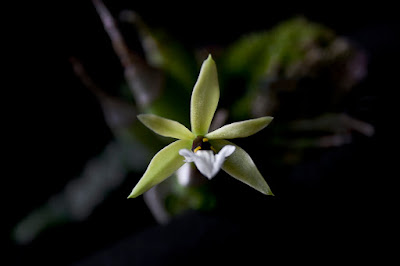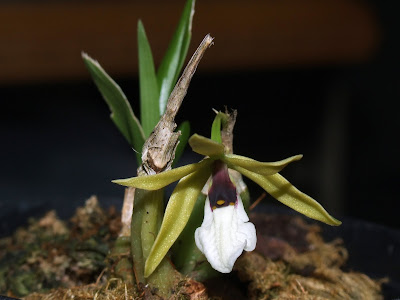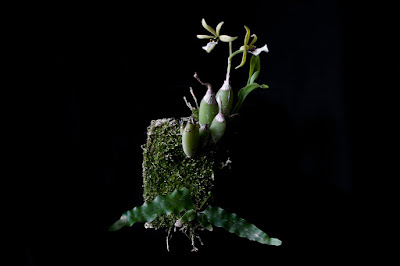Prosthechea micropus flowers are showy, fragrant; sepals and petals pale green to yellowish green, obovate lip white, sometimes with rudimentary....
Prosthechea micropus, also called as Encyclia diguetii, Encyclia tripunctata, Epidendrum diguetii, Epidendrum micropus, Epidendrum tripunctatum, Pseudencyclia tripunctata, is a species in the genus Prosthechea. This species was described by Wesley Ervin Higgins in 2004.
DESCRIPTION OF PROSTHECHEA MICROPUS
Prosthechea micropus is native to Central and Southwestern Mexico. It is found growing in dry oak and pine-oak forest in Nayarit, Jalisco, México, Morelos, Guerrero and Oaxaca at elevations of 1200-2000 meters above sea level.
It is a small sized, cool growing, epiphytic (rarely lithophyte), deciduous species with ovoid to ovoid-ellipsoid, slightly compressed, closely clustered pseudobulbs that are partially enveloped basally by a few scarious sheaths. The leaves are 2-3, narrowly elliptic, acute to obtuse and are deciduous in the winter and starts a new growth in the spring.
This species blooms in spring and early summer from the apical, racemose, 4 cm long, 1-5 flowered inflorescence that arise from the apice of an older leafless, ellipsoid to ovoid pseudobulb as a new growth appears. The flowers are showy, fragrant, 3-4 cm in diameter; sepals and petals pale green to yellowish green, obovate lip white, sometimes with rudimentary lateral lobes, column purple with the apical teeth yellow.
PROSTHECHEA MICROPUS CARE AND CULTURE
Cultural information should only be used as a guide, and should be to be adapted to suit you. Your physical location; where you grow your plants, how much time you have to devote to their care, and many other factors, will need to be taken into account. Only then can you decide on the cultural methods that best suit you and your plants.
Light:
Prosthechea micropus needs a light level of 20000-30000 lux. The light should be filtered or diffused and the plants should not be exposed to direct midday sun. Strong air movement should be provided all the time.
Temperature:
In summer, the average day temperature is 21-24 °C, and the night 13-15 °C, with a daily amplitude of 8-10 °C. In winter the average daytime temperatures are 20-23 °C, and 12-14 °C during the night, while the daily amplitude is 8-11 °C.
Humidity:
This species needs the humidity of 80% in the period of growth, in winter and spring it falls to 60-70%. Too dry air has a negative effect on the development of the plant: its growth is inhibited, and the leaves begin to turn yellow and dry out. The higher temperature, the higher the humidity should be, and the higher the humidity, the more often and longer it is necessary to ventilate the room where the plants are contained, otherwise the probability of rotting and various kinds of fungal diseases. Good air movement is essential while the plants are in leaf and growing.
Substrate, growing media and repotting:
Prosthechea micropus grow well mounted on pieces of tree fern or cork, but in summer this requires high humidity and daily watering. In the period of extremely hot and dry weather, fixed plants may require even several watering times a day.
However, since most growers find it too difficult to maintain sufficient moisture with this growing method, these plants are usually grown in pots using an airy, fast-drying substrate that contains substances such as perlite to keep moisture out and charcoal to keep it airy and prevent acidification. Plants should be repotted at the end of winter or early spring, when new root growth begins.
Watering:
The plants should be watered abundantly during active growth, but their roots must dry out quickly after watering. At the end of autumn, the amount of water should be gradually reduced.
Fertilizer:
This species should be fertilized every week 1/4-1/2 of the recommended dose of fertilizer for orchids. A fertilizer with a high nitrogen content is beneficial from spring to mid-summer, and a phosphorus-rich fertilizer can be used in late summer and autumn. Higher phosphorus content stimulates better flowering in the next season and promotes hardening of new growth before winter.
To avoid the accumulation of mineral deposits during periods of strong fertilization, it is recommended to rinse the containers approximately every month.
Rest period:
Prosthechea micropus needs a dry rest period in winter. Allow the plants to dry a bit before the next watering, but do not let the remaining ones dry for long periods of time. In most cases, light watering every 2-3 weeks and occasional morning misting between waterings are sufficient. Fertilization should be limited or should be abandoned altogether until spring, when stronger watering resumes.















COMMENTS